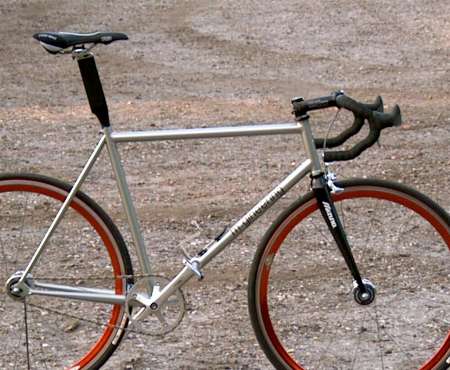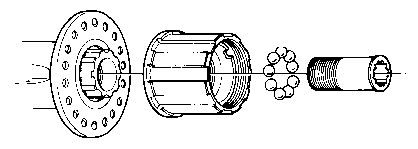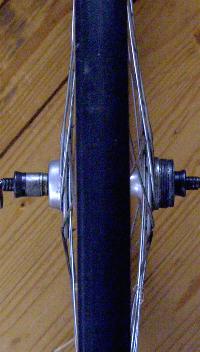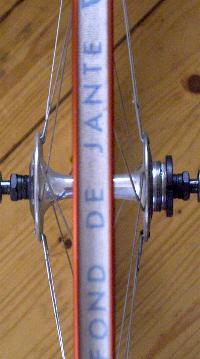Fixed Gear
or the joys of 1880's technology

|
Trackbike
Less is more, this is the
bike I tend to ride most. A fixed-gear bike has no gearchange which makes
cycling wonderfully uncomplicated. You never realise how hard those decisions
to shift gear are untill the option is removed. And the frontbrake (a rearbrake
is unnecessary) can be left alone most of the time as well. In short, a
fixed gear bike is ideally suited to ride away the stresses of everyday
life, not in the least because of the absence of annoying rattles.
And the smooth transmission
(44-17) is supposed to work wonders for your pedalling technique. On the
minus side you have to take a bit of care in corners as the inside pedal
will allways come round to its lowest position from time to time, and a
balanced position is compromised with your legs going up and down. Stopping
pedalling will also give you a nasty surprise! (I use SPD's) |
 |
See for more advice on fixed-gear
cycling Sheldon Browns goldmine: Harris
Cyclery, West Newton, Massachusetts |
A problem when building a fixed
gear bike is how to find a suitable rearwheel. I couldn't locate a wholesaler
or shop with track stuff at first, so I made my own.
You can install a threaded
cog (from an old style coaster brake) on a freewheel type rearhub (screw
it tight, use Loctite and a LH bracket lockring), but to get some sort
of chainline you have respace the axle with loads of washers and reverse
the wheeldish which certainly looks funny! Proper trackhubs
have the flanges much further apart for a symmetric wheel. On the subject
of cogs, some people use Shimano UG locking cogs, which are suitable for
use with narrow chains, but the threading is not quite BSC, so reliability
or the hub may suffer. A proper trackcog is probably best.
An other approach which
does away with threaded cogs is to convert a Shimano freehub. This can
be done with exotic CNC machined parts (Surly?), or by welding up the genuine
article.
Procede as follows:
-
Start with the removal of the
axle and the dustshield of the outer freehub bearing
-
The bearingcup becomes now visible,
and can be loosend using either a drift (lh thread, the notch is visible
in the picture above) or the proper Shimano tool
-
Now remove the freewheelbody
from the hub with a 10 mm Allenkey
-
Remove the bearing cup (a lot
of small bearings will drop out, but you won't need them again) and degrease
-
Replace the bearings with rings
turned on a lathe or made from 3mm steel wire wrapped round a suitable
bar to fill the space previously taken by the bearings, and refit the bearingcup
-
TIG-weld the reverse side of
the freewheelbody
Rebuild the hub, and fit a cog
(a Shimano BMX freehub cog with big teeth would be nice) together with
a stack of spacers salvaged from junked cassettes. If your horizontal dropouts
are long enough you could even fit two cogs for a change in gearing.
 
a standard hub (left) vs
a proper trackhub (right)
|



